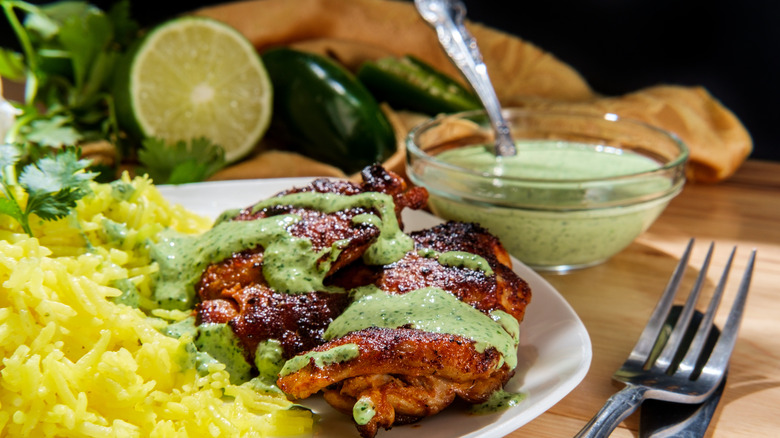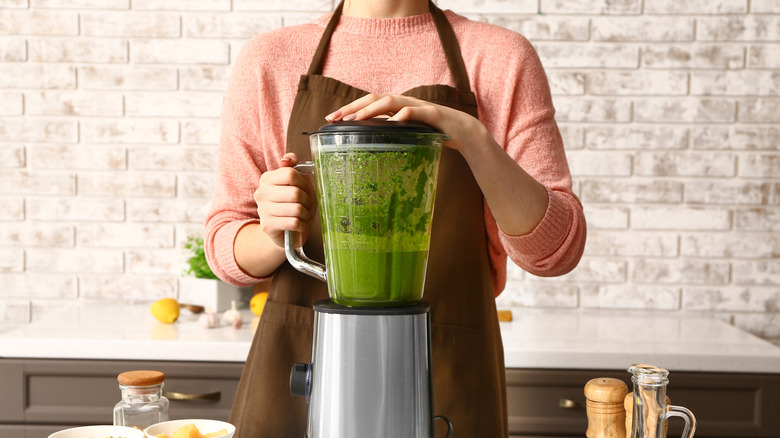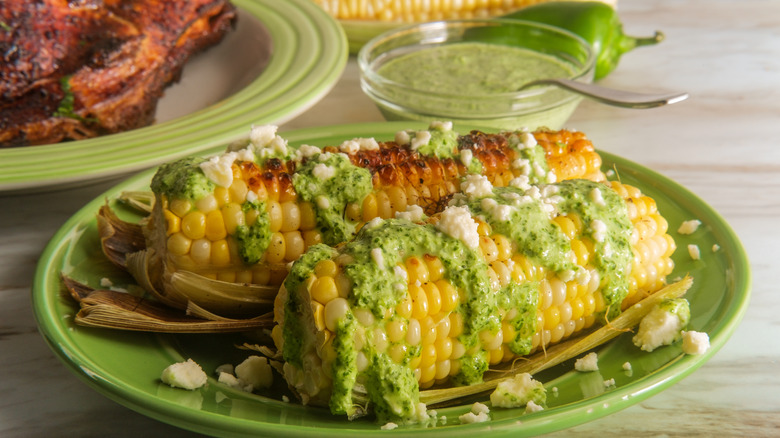Ají Verde Is The Peruvian Green Sauce That'll Elevate Your Roast Chicken
One taste of ají verde, and you may never look at Peruvian food the same way again. The country that brought us ceviche also concocted one of the greatest sauces of all time. Spicy, creamy, citric, and bright, ají verde is a great addition to any dish but goes particularly well with grilled chicken and other meats. Fair warning: This is a hot sauce. Although it's well-balanced, if you don't like spicy food, this may not be your cup of tea. For everyone else, welcome aboard the ají verde train.
Traditionally, ají verde is made with ají amarillo, which is Spanish for "yellow chile." With a Scoville rating of 30,000-50,000, ají amarillo is in the same ballpark as cayenne pepper. In the U.S., they are often substituted with jalapenos, which are more widely available and a little bit more approachable for people who aren't looking for that level of heat.
The other main ingredient that is often substituted is huacatay, aka black mint, which can sometimes be found in the Latin aisle of your grocery store alongside ají amarillo paste. There are many variations of this sauce, so if you can't find either of those ingredients, don't worry. It may not be the authentic Peruvian version, but you can get pretty close with substitutions.
How to make ají verde
Ají verde is made by blending peppers, herbs, and mayonnaise into a creamy sauce. Ají amarillo is the quintessential Peruvian pepper for this condiment, but jalapenos are a popular substitute if you want to tone down the heat. A generous helping of cilantro and a clove of garlic are almost always included, which give the sauce a bright, botanical flavor. Some recipes call for the addition of mint, scallions, and basil, but they aren't 100% necessary.
An important part of the sauce is the base. Mayonnaise is a popular choice for its creamy texture and its ability to take the edge off of the spice while leaving the flavor unhindered. Greek yogurt or olive oil can be substituted for the mayonnaise if you prefer, and Cotija cheese is often used to bring a salty element to the dish. Finally, squeeze some fresh lime juice to top it off, and there you have it. Combine everything in a blender and pour the resulting sauce into a bowl or jar. If you use olive oil instead of yogurt or mayonnaise, it will keep longer in the fridge, but you won't really get the creaminess that ají verde is known for. Without that creaminess, you have something a little closer to a chimichurri sauce.
What to use ají verde with
As anyone who's tried ají verde knows, it goes well with basically anything. Put it on burgers, eggs, roasted vegetables, or your next batch of ceviche. That said, ají verde really shines when paired with grilled or roast chicken and other meats including grilled fish. If you eat at a Peruvian restaurant serving pollo a la brasa (Peruvian chicken), you should keep an eye out for a bottle of ají verde sauce because the two go together like bread and butter.
There are a lot of green sauces in Latin American cuisine, from chimichurri to salsa verde to cilantro pesto. But, while they may look similar, each green sauce accomplishes a different goal. Salsa verde is closer to a dip with tomatillos at its heart, cilantro pesto is more of a sauce, and chimichurri also goes well with grilled meat but is more herby than spicy. Ají verde is a hot sauce through and through, a true love letter to the world of Andean chile peppers.


